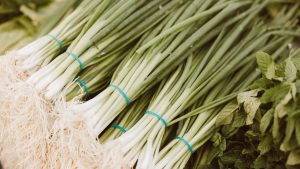Last Updated on March 19, 2025 by teamobn
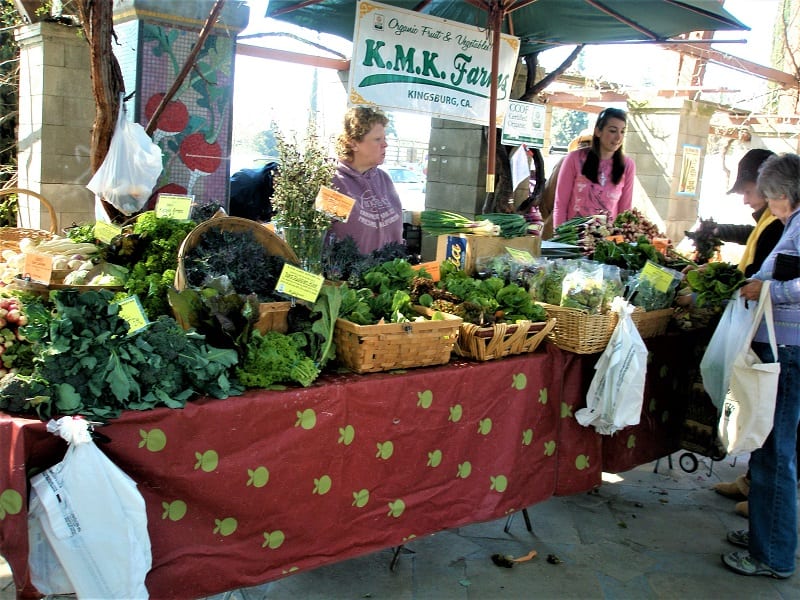
To some they are eco-capitalists. To others, they are die-hard hippies. The truth might be somewhere in between. Up until the so-called “Green Revolution” of the 1970s, many farmers grew crops as organic market gardeners do today.
Granted, the learning curve couldn’t have been easy. Farmers learned to manage soil nutrients without synthetic fertilizers. They controlled weeds and pest populations without herbicides and insecticides.
Why would any grower today choose to go through such difficulties when easier options are available?
We could say organic market gardeners do it out of concern for the health of consumers. Or we could say they do it because they genuinely care about the environment. Both assumptions can’t be too far-fetched.
However, the simplest – and probably the most accurate – the answer would be money, of course. Organic food sales increase by double digits each year in the US.
The annual increases far outstrip the growth rate for the overall food market. The US organic food industry was valued at around $50 billion in 2019 alone.
To help you tap into into the market, lets go through the most handy organic gardening equipment you can buy.
Useful Organic Gardening Equipment
Contents
Now, the sizeable revenue stream might lead you to think that organic gardeners must necessarily use sophisticated, hi-tech tools. The truth – again in this case – is a mixed bag. Some do. Many don’t.
Below are four simple implements you’ll likely find in an organic market gardener’s toolshed.
1. Precision Seeder
Precision seeders allow you to make a much quicker job of sowing seeds in beds. The simple devices use a cog system to automatically distribute seeds at various distances and depths.
You’ll find many precision seeders online. We favor the Precision Garden Seeder. With this garden seeder, you get seven seed plates for planting lots of types of small and large seeds.
You can use the seeder to plant hemp, sweet corn, beets, peas, radish, and leeks among others. The large seed hopper can hold seeds for a ½ acre garden.
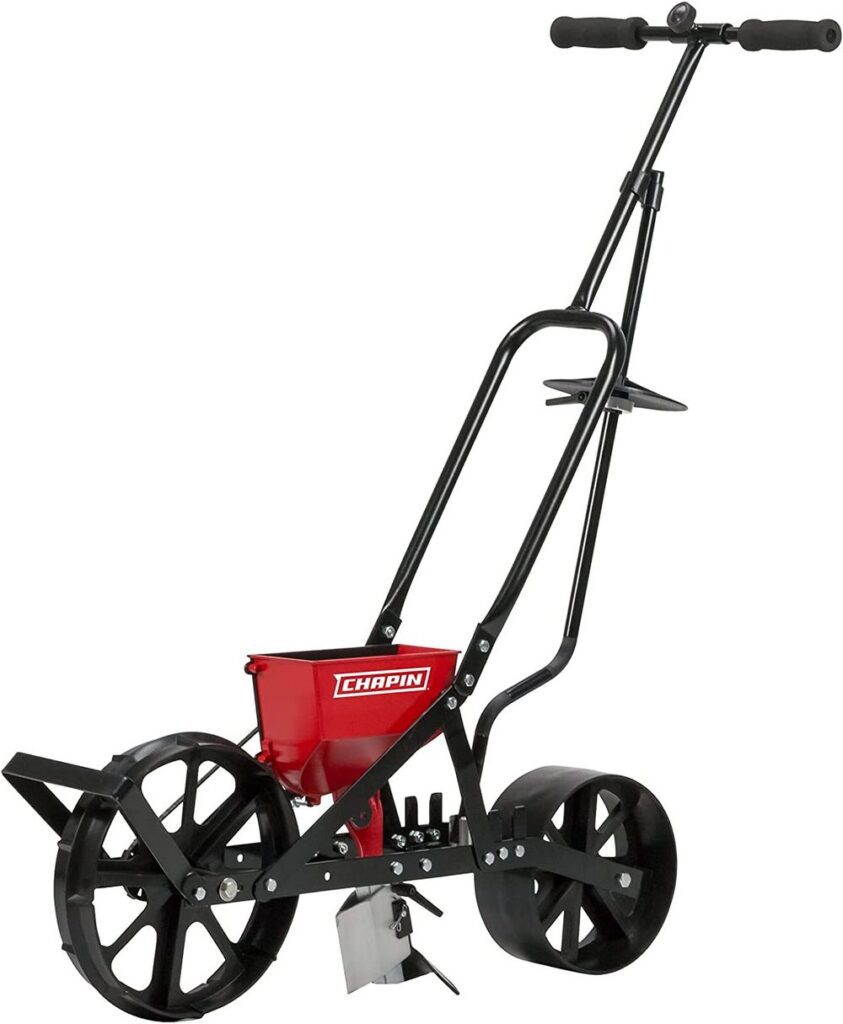
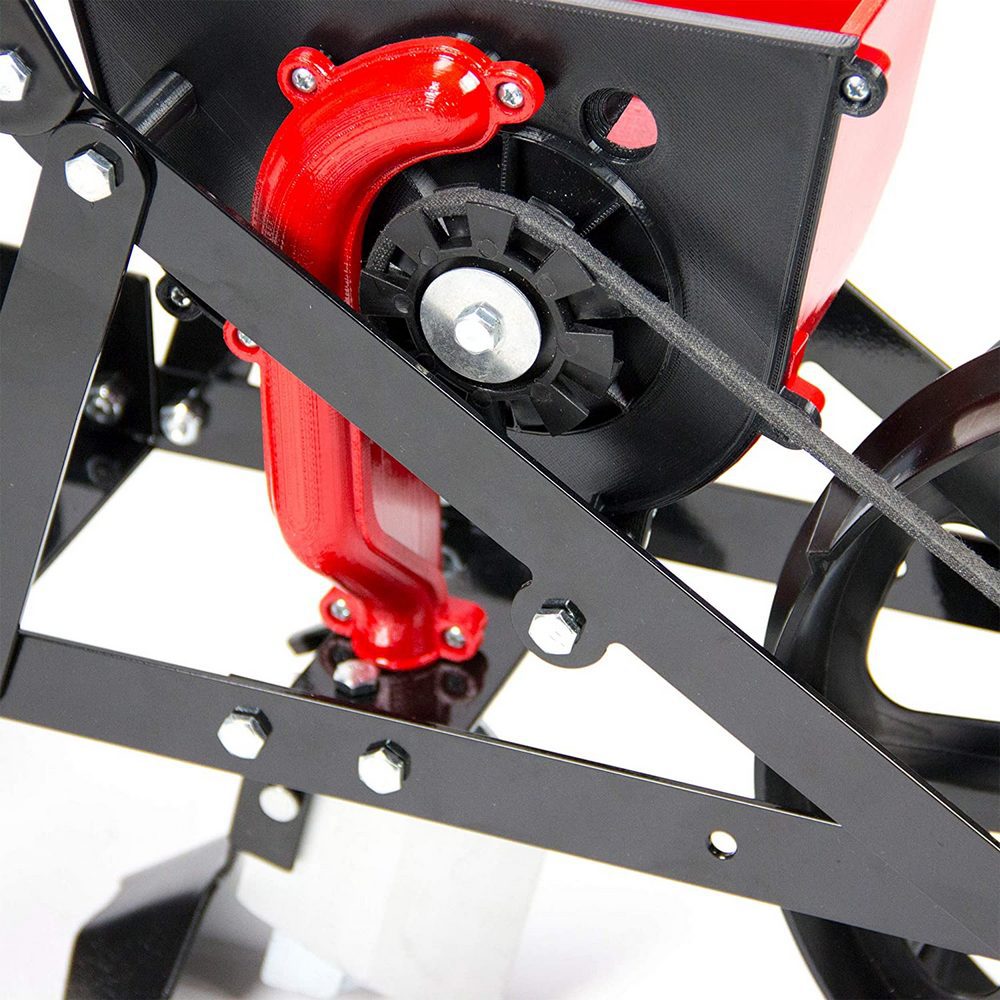

2. Wheel Hoe
The humble wheel hoe has been around for quite a while now. Wheel hoes are tools you push through the rows of your garden to weed, till, cultivate, or plow. They have one or two wheels in front, a tool-mounting area in the middle, and handles in the rear. Depending on the attachment you fasten to it, you can use a wheel hoe for a variety of gardening tasks.
The Hoss Double Wheel Hoe has become one of the most trusted implements in the organic market gardener’s toolshed. This wheeled implement is small enough to maneuver areas that motorized tillers can’t reach.
The extra wheel provides added stability even as the overall design lets you straddle a row when plants are small. This allows you to weed both sides in one pass – a great time-saver for growers with busy schedules.
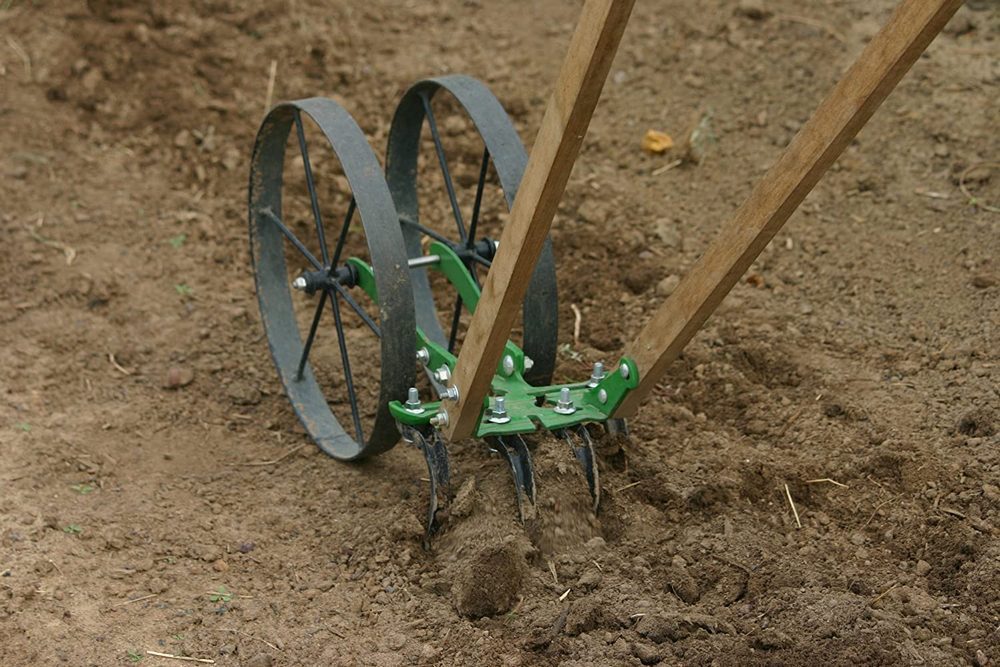
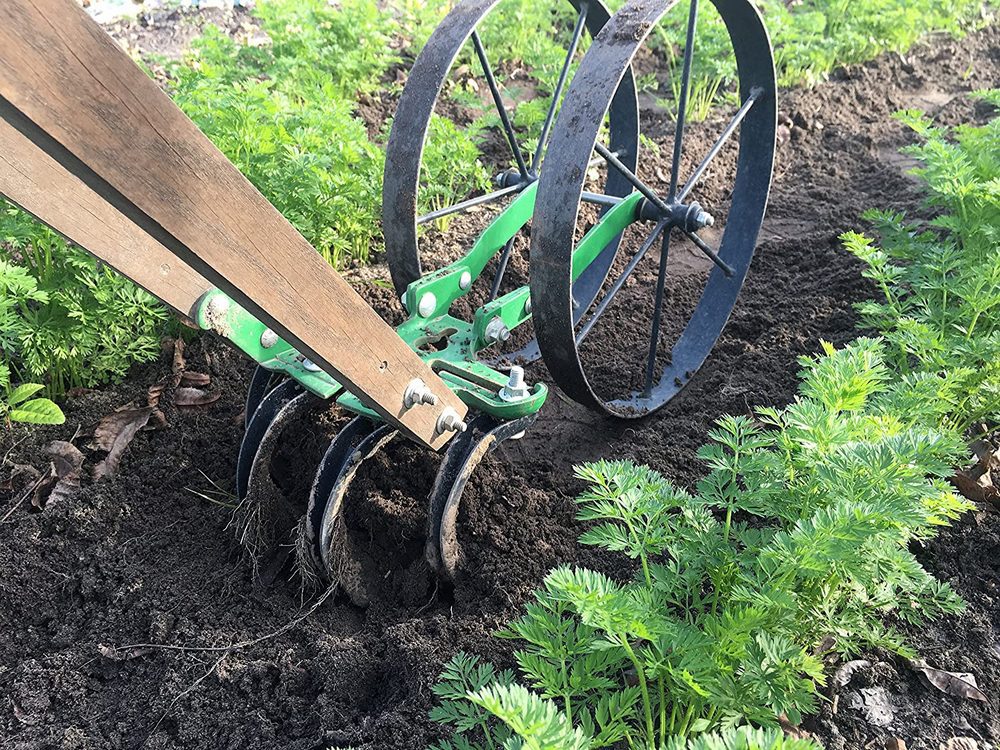

3. Oscillating Hoe
The oscillating stirrup hoe is among the simplest, most inexpensive – yet effective – weeding tools available to gardeners. Their function makes them doubly important to organic growers, who do not use herbicides on their plots.
We like the Truper Action Hoe for its simplicity and all-around usefulness. Similar in design to a scuffle hoe, this oscillating hoe works on a hinged action. The blade allows you to cut weeds in both a forward and backward direction.
You use the hoe like a broom as you move up a plot. The sharpened blade easily slices through soil and eliminates weeds in its path.
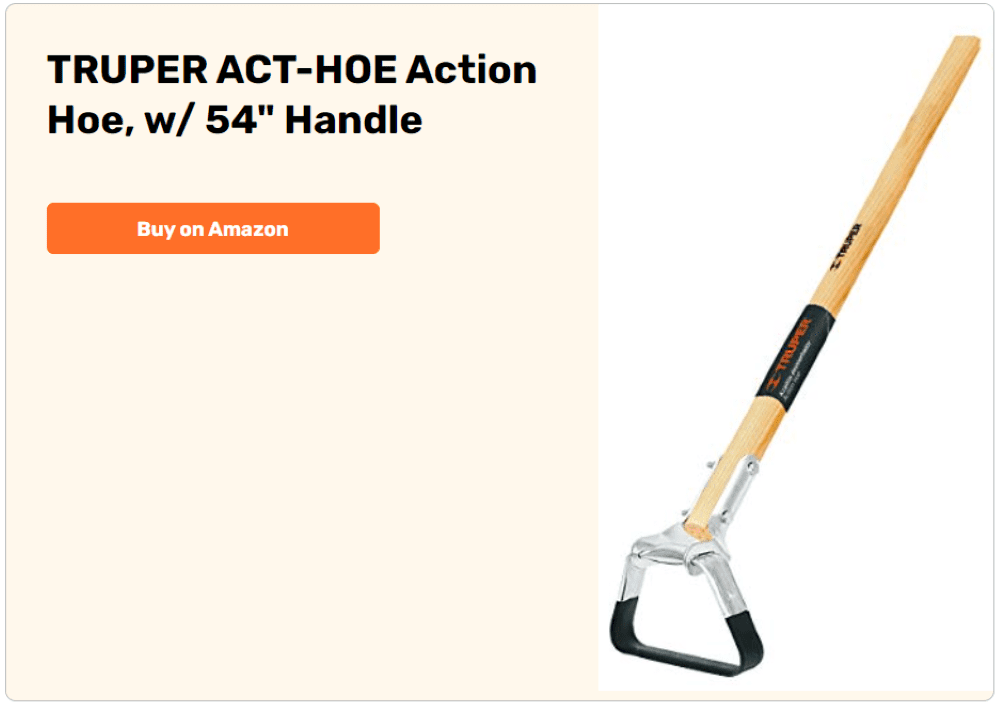
4. Gardener’s Multi-Tool
With so many things to cut, trim, and prune, organic gardeners often need to lug around all sorts of tools. This can be cumbersome and exhausting. The solution? A sturdy and compact multi-tool like the Gentleman’s Hardware 7-in-1 Garden Multi-Tool.
This clever implement is a pruner and accessory toolset designed for the gardener. From clearing small branches from trees to pruning bushes, and weeding, this multi-tool does it all.
This tool contains pruners, a root remover, a knife, a saw, a screwdriver, a bottle opener, and a weeding utensil. When not in use, each tool folds into the wooden handle for easy transport and storage, too.
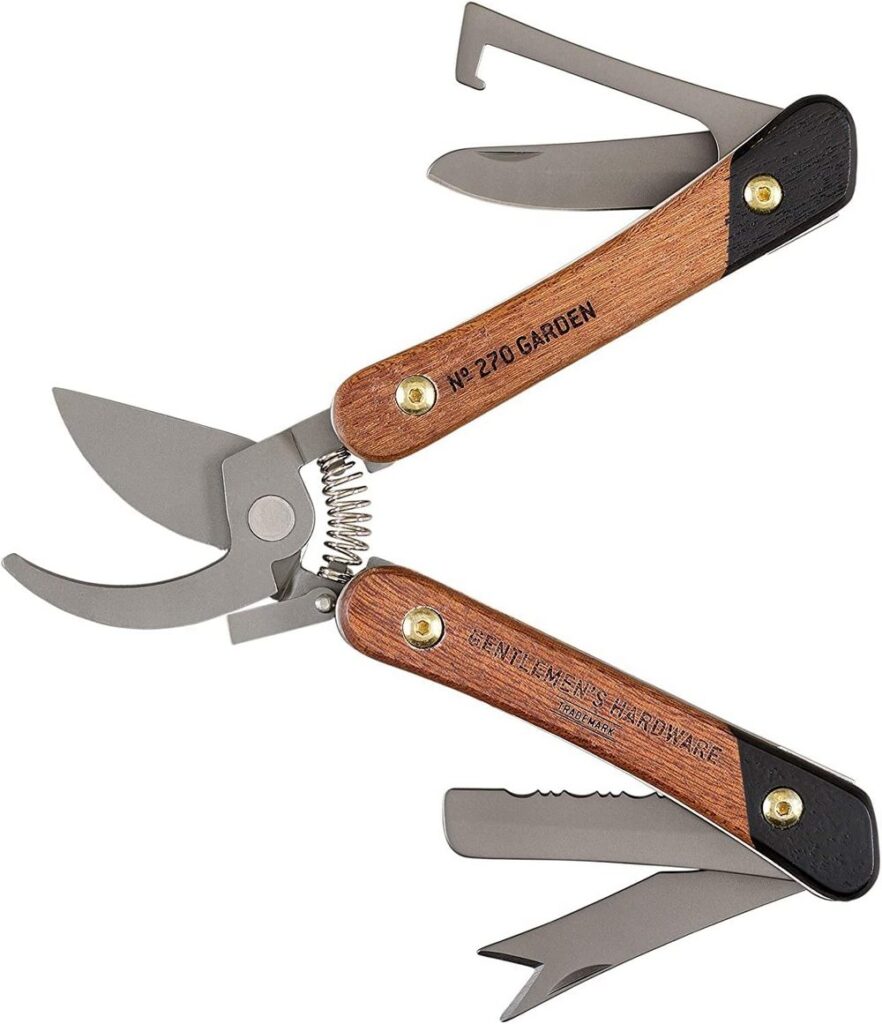
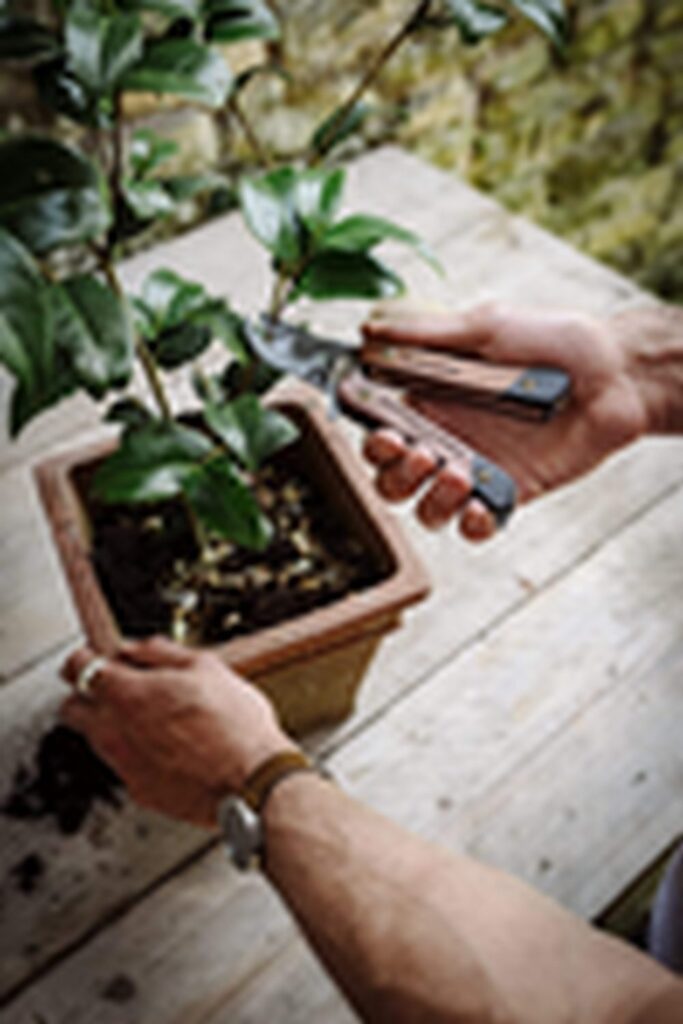

These days, more and more consumers are eating organic food to reduce the pesticides they consume and protect the environment. If you are one of them, then you know that buying organic can get expensive.
Fortunately, you can always grow your own organic produce – or perhaps even start an organic market garden.
Organic gardening means you won’t use synthetic fertilizers or pesticides. Of course, that doesn’t mean your plants will fend for themselves.
You’ll need an array of tools to ensure plant health and ward off pests. The list above can be a good place to start.
But if you’re new to organic gardening, it would be better to start small. Experiment with just a few initial plants in the backyard. Don’t worry if things aren’t perfect right away, too. You’ll get the hang of it soon enough.
How to Choose the Right Organic Farming Equipment for Small-Scale Farms
Starting an organic farm on a small scale is rewarding but comes with its challenges. One of the most important decisions you’ll make is choosing the right tools. The right organic farming equipment can help you work more efficiently, reduce physical strain, and improve your crop yield. It doesn’t have to be expensive or high-tech. Often, simple hand tools are all you need to get started and maintain a healthy, productive garden.
Understand Your Farming Needs
Before you buy any tools, take time to evaluate your farming goals. What crops are you planning to grow? How much land will you cultivate? These two questions will help narrow down the essential equipment for your setup. For example, if you’re growing root vegetables like carrots or beets, you’ll need tools that can handle precise seeding and soil preparation. If you plan to grow a variety of crops, versatility should be a priority in your equipment choices.
Choose Multi-Purpose Tools
Space and budget are often limited on small farms. Multi-purpose tools can be a game-changer. A gardener’s multi-tool, for example, combines several functions into one compact device. It can handle tasks like pruning, trimming, and weeding without the need for several separate tools. Choosing versatile equipment saves money and reduces clutter in your toolshed.
Focus on Soil Health Tools
Organic farming depends on healthy soil. Avoiding synthetic fertilizers means you’ll need tools to help manage soil health naturally. A wheel hoe is a valuable piece of organic farming equipment that makes cultivating and aerating soil much easier. It’s simple to use and can replace heavier, motorized tillers that are often overkill for small plots. The wheel hoe also allows you to weed and cultivate between rows without disturbing plant roots, keeping your soil structure intact.
Look for Precision Planting Tools
Plant spacing is critical in organic farming. Proper spacing can reduce pest problems, prevent disease, and improve airflow around plants. A precision seeder is one of the best investments you can make. It helps you sow seeds at the right depth and spacing, improving germination rates and reducing the need for thinning later on. This type of organic farming equipment saves time and reduces waste, especially if you’re planting small seeds like lettuce, radish, or spinach.
Prioritize Ease of Use and Durability
Small-scale farming requires tools that are comfortable to use. Look for ergonomic designs and lightweight materials that won’t cause fatigue. Stainless steel blades, hardwood handles, and rust-resistant finishes are all signs of durable equipment. Reliable tools reduce the need for frequent replacements and repairs, saving you money in the long run.
Start with the Basics and Expand Over Time
You don’t need every tool on day one. Start with essential equipment like a wheel hoe, oscillating hoe, and a reliable multi-tool. As your farm grows, you’ll better understand what additional tools you might need. Expanding your collection gradually lets you invest in quality rather than quantity.
Choosing the right organic farming equipment is key to building a productive small-scale farm. Focus on tools that support healthy soil, efficient planting, and chemical-free pest control. With the right setup, you can work smarter, not harder, and enjoy the rewards of organic farming.
Maintaining Your Organic Farming Equipment
Organic farming tools are an investment in your garden’s health and productivity. Proper maintenance ensures they stay effective and last for years. Well-cared-for organic farming equipment not only saves you money but also helps maintain efficiency in your daily tasks.
Clean Tools After Every Use
Dirt, sap, and plant residues can cause rust and dull blades if left on your tools. After each use, take a few minutes to wipe your tools clean. Use a brush to remove soil from hoes and seeders. For tools with blades, like pruners or multi-tools, a damp cloth works well. Keeping your equipment clean reduces wear and prevents the spread of disease between plants.
Dry and Store Properly
Moisture is the enemy of metal tools. Once cleaned, dry your tools thoroughly to prevent rust. Store them in a dry place, preferably hanging on a wall or in a toolbox, to keep them off damp ground. If you use wooden-handled tools like wheel hoes, keep them out of direct sunlight to prevent the wood from cracking.
Sharpen Blades Regularly
Sharp blades make gardening easier and more precise. A dull blade can damage plants and make tasks like pruning or weeding more strenuous. Use a sharpening stone or file on tools like oscillating hoes and pruners. Regular sharpening keeps your organic farming equipment working smoothly and reduces strain on your hands and arms.
Oil Moving Parts and Metal Surfaces
Apply a light coating of oil to metal parts and joints. This protects against rust and keeps moving parts like hinges on your multi-tool operating easily. Linseed oil is a great choice for wooden handles, helping to prevent drying and splitting.
Check for Loose or Damaged Parts
Inspect your tools regularly for signs of wear. Tighten loose screws and replace damaged parts as soon as possible. Early repairs can prevent bigger problems later and keep your tools safe to use.
Invest in Quality and Handle with Care
Quality organic farming equipment is built to last, but how you handle it matters. Avoid using tools for tasks they weren’t designed for. For example, don’t use your precision seeder to plant seeds that are too large for the plates. Proper use reduces unnecessary wear and tear.
Proper maintenance extends the life and efficiency of your organic farming equipment. With regular care, your tools will serve you well season after season, helping you grow a productive and healthy garden.
Conclusion
For small-scale producers, these four organic farming tools—precision seeder, wheel hoe, oscillating hoe, and gardener’s multi-tool—are straightforward yet quite powerful. Without depending on chemicals or heavy machinery, they assist to preserve good soil, control weeds, and increase efficiency. Investing in the correct tools helps organic gardening to be sustainable over time, more efficient, and easier overall.


